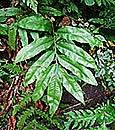Bolbitis auriculata (Lam.) Alston
Synonyms |
Acrostichum auriculatum Lam. |
|---|---|
Common name |
|
Description |
Rhizome creeping, 3–7 mm diameter; rhizome scales scattered, dark brown or blackish, deltate-lanceolate in outline, margin subentire, 2–3 mm long. Fronds 15–40 mm distant, 30–115 cm long. Stipe 1/2 –7/10 the frond length, straw coloured, scales linear-lanceolate in outline, black, with occasional short teeth, scattered, especially near stipe base. Sterile fronds 22–38 cm long, 28–40 cm wide; apex subconform, without buds; pinnae in 2–5 (mostly 3) pairs, elliptic, 15–28 cm x 3.8–6.3 cm, lower pinnae stalked to 8 mm, usually with auriculate bases, upper pinnae broadly adnate, medial pinnae with narrowly cuneate base, acuminate or rarely long-acuminate apex, more or less symmetrical, rarely with axillary bud, margin entire to finely serrulate, crenate to irregularly lobed; veins netted without or rarely with a few included veinlets. Fertile fronds with stipe 3/4 the frond length; pinnae 6–11 cm x 1.2–2.4 cm, often with basiscopic lobes on basal pinna pair; sori acrostichoid. |
Notes | Bolbitis auriculata is distinct by its usually auriculate lower pinnae, few large pinnae, and a bud borne axillary at base of basal pinnae. |
Derivation | auriculata: having one or more structures shaped like an ear lobe, referring to the base of the lower sterile pinnae. |
Habitat | Moist forest, often in moist sites. |
Distribution worldwide | Africa, Madagascar, Réunion, Comoro Is., Mauritius. |
Distribution in Africa |
Angola, Benin, Burundi, Cameroon, Central African Republic, Congo, Dem. Republic of Congo, Equatorial Guinea (incl. Bioko), Gabon, Ghana, Guinea, Ivory Coast, Liberia, Nigeria, Sierra Leone, Sudan and South Sudan, Tanzania , Togo, Uganda. |
Growth form |
Lithophytic, terrestrial. |
Literature |
|
